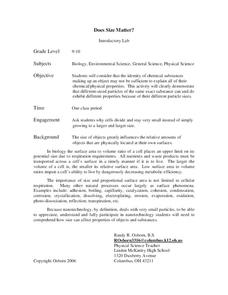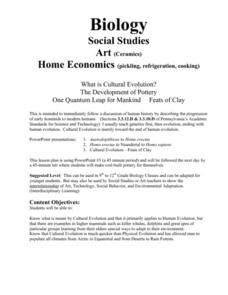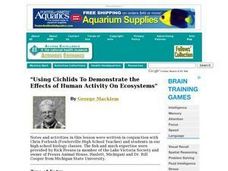Curated OER
Does Size Matter?
Students explore the surface area to volume ratio in cellular respiration. While participating in an interactive lab experiment, they examine proportional surface area and discuss nanotechnology. Students observe the effectiveness of...
Curated OER
Population Density
Middle schoolers use the scientific method to conduct an experiment and use varied methods to gather background information. They correctly use lab equipment and prepare tables and graphs that organize, conclude, and present their...
Curated OER
Mining and Land Reclamation - A Classroom Simulation
Students simulate mining mineral resources using cookies. In this earth science lesson, students analyze the cost and profits in mining. They write a lab report about the activity.
Curated OER
What's in Our Woods?
Students observe their local forest and document the change that occurs over the school year. For this forestry lesson, students utilize a GPS to mark a certain area of the woods as their study area for the remainder of the year....
Curated OER
South Pole Base Gamma
Pupils design a South Pole base. In this science instructional activity, students discuss characteristics of the South Pole and work in a group to design a base that will be named "Gamma." Pupils sketch their design.
Curated OER
Microbe Power- Using a Winogradsky Column as a Battery
Students demonstrate the changes that take place when they complete their experiment. In this battery lesson students complete a lab activity.
Curated OER
The Cantankerous Pathogen
Students explore what factors influence the spread of infectious diseases. They explain how human manipulation of the environment affects the transmission of diseases.
Curated OER
History of Theory of Evolution
Students infer evolutionary relationships by comparing the physiological data or description. They write what they think would happen if a brown bear in the woods had an offspring that was white. Would this help the baby bear in its...
Curated OER
Common Adaptation Patterns
Students become familiar with common categories of animals and discover adaptation patterns and structures in animals that help them survive in different environments. Students identify major structures of common animals.
Curated OER
Phytoremediation
Students participate in a lab designed to facilitate the clean up and remove of substances ranging from heavy metals to dynamite. They focus on the remediation of copper. They discuss their results of this open ended inquiry experiment.
Curated OER
A Global Water Crisis
Students study the contamination of drinking water and what human activities play a role in it. In this environment lesson students complete worksheets and complete a lab activity.
Curated OER
Moving without Wheels
Students observe a simple water cycle model to better understand its role in pollutant transport. This activity shows one way in which pollution is affected by the water cycle; it simulates a point source of pollution in a lake and the...
Curated OER
A Natural Habitat: What, How and Why
Students understand what a habitat is. They determine why a habitat is important to our environment no matter where it is located. Students observe and recognize natural habitats in their surroundings.
Curated OER
Beneficial Bug Scavenger Hunt
Students identify several beneficial insects and spiders, including predators and pollinators. They search an outdoor environment and record numbers and types of beneficial insects and spiders that they discover.
Curated OER
Creating an Experimental Design
Students research the damage to the environment by certain plant species. They create an experimental design which they test how these species take over certain habitats. They share their information with the class.
Curated OER
What is Cultural Evolution?
Students comprehend what is meant by Cultural Evolution and that it primarily applies at Human Evolution, but that there are examples in higher mammals such as a killer whales, dolphins and great apes of particular groups by exploring...
Curated OER
Acid Rain: Where Have All the Rainbows Gone?
Learners study the pH scale and sources of acid precipitation. In this acid rain instructional activity students complete a lab on acid rain then complete a handout.
Curated OER
Finding the Basal Area of a Forest Plot to Determine Stocking Levels
Students use graphs and plots to measure the basal area and stocking levels. In this graphing instructional activity students work in the field the use their data to help them complete a lab activity.
Curated OER
Comparing Light Bulbs
Fifth graders compare filaments in different light bulbs. In this science instructional activity, 5th graders view the filaments of light bulbs under a microscope.
Curated OER
Thinking Like a Scientist
Pupils examine what it is like to be a scientist. In this living environment instructional activity students complete a group lab activity and answer questions.
Curated OER
Groundwater as Part of the Water Cycle
Ninth graders study the effects of soil and rocks on filtering groundwater. In this groundwater lesson students complete a lab activity that includes sources of contamination.
Curated OER
Sample Activity From The Water Sourcebook
Students explore septic system failures and contamination of groundwater. The complete a worksheet to explore the basic parts of a septic system. In a lab situation, students simulate a septic system failure. They explore coliform...
Curated OER
"Using Cichlids To Demonstrate the Effects of Human Activity On Ecosystems"
Students explore the freshwater ecosystem of Africa's Lake Victoria by creating a freshwater aquarium. They investigate factors affecting the aquarium's ecosystem and conduct lab activities.
Alabama Learning Exchange
Plants, Soil and Nutrients
Young scholars conduct an experiment. They review how to use the scientific method to conduct an experiment with white carnations and food coloring. They create a hypothesis and test it to better understand how plants get nutrients,...























